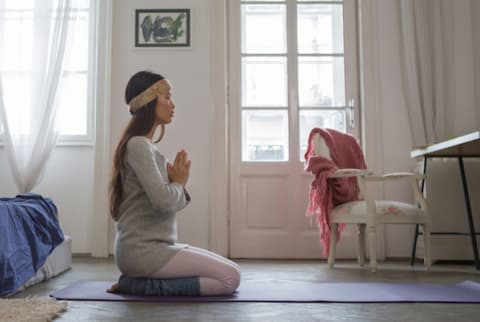Advertisement

A morning practice is an opportunity to meet with our essential selves before letting the world in. The magic that is inherent in the morning is what keeps us more in tune and able to meet challenges. It sets the stage for how we want to nourish and treat others and ourselves throughout the day.
Here are eight tips to nurture your morning practice, developed after years of flowing in and out of one myself.
1. Start small and build from there.
Set a timer, literally for one minute, and then maybe three or five — up to as long as you have time for. Sometimes if we just get one minute of meditation or breath work in, that's all we really need.
2. Wake up as naturally as possible.
Although some of us have important responsibilities first thing in the morning, waking up naturally is one way of staying in rhythm with the innate cycles of our bodies.
If you have to use an alarm clock (which I often do) try the type that uses nature sounds, or one that slowly illuminates to wake you up, without jarring you. Allowing my natural alarm clock to wake me up is what took my morning practice to the next level. It also helps to stick to a commitment of turning off your phone and keeping it in another room. This will help you begin your morning with ritual and practice, rather than stress.
3. Make your practice practical.
A morning practice must be reasonable. If you work late nights, don't try to set your alarm for the early morning dawn hours just because that is the most auspicious time. Be gentle with yourself and be sure to get enough sleep before you practice.
4. Utilize your surroundings.
If you have children or pets, involve them! If the only personal space or time you have is when you're in the bathroom ... use your bathroom! Sit on the edge of the tub or the toilet, light a candle and do three minutes of deep breathing or prayer. It's better than nothing, I assure you.
Using our surroundings allows us to get creative and reminds us there are always possibilities, even in less than ideal circumstances.
5. Accept your imperfections.
If it was supposed to be perfect, it wouldn't be called a practice. There is literally no right or wrong way to have a spiritual practice. There is only learning the art of what it means to be human.
6. Find your edge and move past your comfort zone.
If we're not leaning into what scares us, we're living life with one foot in and one foot out. When we find our edge in our practice and it makes us a bit uncomfortable, we allow ourselves to be vulnerable. And when we learn to embrace vulnerability with ourselves, we can move toward being vulnerable with others.
7. Include physical, mental and spiritual components.
Many practices intersect. For example, journaling — a mental activity — can also be a form of prayer. Practicing asanas or taking a walk, can be forms of moving meditation.
8. Let your practice flow organically.
Listen to your intuition and know that the mind and body may need different things on different days.
Create a list of things you love to do, and that you know you can do for yourself in the mornings. Choose a few and mix them up, based on how much time you can set aside that day, how you're feeling, what you're inspired by.
My practice can change every single day, and that reflects the flexibility we need in this rapidly changing world.
We feel best when we treat ourselves well, given our circumstances and resources, and that translates into how we treat others and how we share our gifts with the world. With the magic of the morning, we can utilize our innate need for connection and ritual, to guide through the transitions of this beautifully complex world with more awareness and joy.
Watch Next
Enjoy some of our favorite clips from classes
Enjoy some of our favorite clips from classes
What Is Meditation?
Mindfulness/Spirituality | Light Watkins
Box Breathing
Mindfulness/Spirituality | Gwen Dittmar
What Breathwork Can Address
Mindfulness/Spirituality | Gwen Dittmar
The 8 Limbs of Yoga - What is Asana?
Yoga | Caley Alyssa
Two Standing Postures to Open Up Tight Hips
Yoga | Caley Alyssa
How Plants Can Optimize Athletic Performance
Nutrition | Rich Roll
What to Eat Before a Workout
Nutrition | Rich Roll
How Ayurveda Helps Us Navigate Modern Life
Nutrition | Sahara Rose
Messages About Love & Relationships
Love & Relationships | Esther Perel
Love Languages
Love & Relationships | Esther Perel












